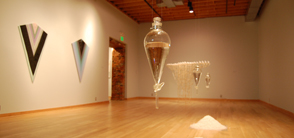"Putting Baltimore artists on the MAP for 35 years"
By Neil Kenworthy, Staff Writer on October October 12, 2016 | Baltimore Watchdog
In the late 1990s, Mina Cheon went from place to place searching for a gallery in the Baltimore area to display a new large-scale project she called “SCI-ART.”
After hearing good things about the Maryland Art Place, Cheon decided to meet with some of the board members to set up an exhibition.
More than 15 years later, the South Korean-born artist is still on display at MAP, a not-for-profit organization for the visual arts and creative community on Baltimore’s west side.
“I’ve worked with Maryland Art Place since 1999,” Cheon said. “I love being part of this.”
Cheon’s 10-foot tall “Pink Diamond” sculpture, which is part of a series she began with her husband Gabriel Kroiz in 2007, illuminates the inside of MAP’s front window and is part of the organization’s 35-year anniversary exhibition.
The celebration began last Thursday evening, when MAP opened its doors for the “soft” debut of the anniversary exhibition, which features 35 of the most influential artists that have worked with MAP over the years.
The organization is hosting an open house this Sunday where the community is invited to view the five-floor exhibit as well as meet the artists and creative businesses hosted by MAP.
MAP’s 35-year anniversary opening night was an appreciation of the past with an eye on the future. Both former and current members of MAP’s staff and board gathered to celebrate the journey.
“I’m just amazed that [MAP] is still here,” said Glorian Dorsey, MAP’s first president. “I was always worried because we would move from one [building] to the next and it was always by the skin of our teeth, but I’m delighted.”
Amy Cavanaugh Royce, the organization’s executive director said, MAP purchased the 20,000-square-foot venue on Saratoga Street in 1988 before its board decided in 1999 to move to Power Plant Live.
After spending almost 15 years at Power Plant Live, MAP permanently moved back to its Saratoga Street venue in 2014, the group’s website said.
The move back to Saratoga Street coincided with Maryland economic development officials’ decision in 2012 to create the Bromo Tower Arts and Entertainment District. The district is designed to help revitalize downtown’s west side by filling vacant storefronts and attracting other artists to the area through tax benefits, according to the Baltimore Sun.
“We were already planning to move back [to the Saratoga Street venue],” Royce said. “But with the creation of the Bromo [Tower] Arts and Entertainment District… it gave us that final push.”
Serving 3,000 to 4,000 artists while displaying 400 to 500 artists in galleries every year, MAP has played an intricate part in Baltimore’s cultural community, Royce said.
Christopher Janian, the president of MAP’s board of trustees, said the organization gives artists a platform to display their work while also introducing city residents to innovative paintings, sculptures, photographs and other forms of artistic expression.
MAP does this, Janian said, through various events, such as its Out-of-Order Spring shows in which wall space is completely open to anybody.
“Right now, [MAP] is pretty much an organization of firsts,” Janian said. “Sometimes it’s an artists’ first piece they’ve shown and its sometimes a patrons’ first art purchase. We’re really proud of what we’re doing right now and hope to expand.
While the first floor of MAP currently houses its anniversary exhibition, the building also has exhibits on the third and fifth floors.
Among the more interesting features of MAP, the 14Karat Cabaret is located in the basement. This is an ongoing set of music, dance and film performances in an informal nightclub setting.
The 14Karat Cabaret is currently working on obtaining a liquor license by Oct. 16 to get it back to being fully functional, Royce said.
To maintain a creative environment, artists also live in the building.
“It’s a whole building,” Royce said. “We’ve basically spent the last two years making sure everyone who moves into the building is creative. We have a hip-hop music producer on the second floor; we have a fashion designer on the second floor; seven studio artists on the third floor… They’re all here.”
One of those tenants, Carlyn Thomas, was a former MAP intern who is now co-directing and co-curating galleries on the third floor with Brooks Kossover. Their artist-run gallery, Terrault Contemporary, is not affiliated with MAP but is hosted by the organization.
After moving into the building in July, Thomas and Kossover were able to completely build out their gallery space. In the first room on the left on the third floor, Terrault Contemporary extended the walls, installed new lighting and redid the floors, Thomas said.
The month-and-a-half building project was in preparation to house artist Pete Cullen’s “Quincux” gallery, which opened Saturday through Terrault Contemporary.
Among MAP’s key contributors is former Marine Greg Lamberson, who is responsible for renovations on every floor of MAP’s building, Royce said.
Royce said patrons who visit Sunday’s open house will get a chance to meet the members, friends and contributors of MAP.
“The biggest thing about MAP is that I might be the director, and there were directors before me, but this organization run by a lot of people,” Royce said. “A lot of volunteer hours, a lot of sweat, a good board and founders who still come back today.”
Published by the Baltimore Watchdog


.jpg)
.png)
.png)
